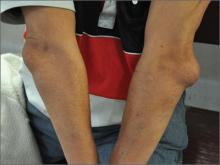The FP recognized that this was a case of bilateral olecranon bursitis, and that the patient’s left arm was most affected.
Knowing that there are many causes of olecranon bursitis, the FP decided to aspirate the fluid for further diagnosis. The fluid didn’t appear infected, but under the microscope, the FP could see small linear crystals that were consistent with uric acid crystals. Upon further questioning, the patient remembered having had a painful episode 5 years earlier involving swelling of his big toe.
The patient was told to take over-the-counter ibuprofen 3 times daily with food and was sent for some blood tests. The blood tests revealed a normal complete blood count and a metabolic profile revealed an elevated uric acid level of 9 mg/dL. A 24-hour urine test for uric acid was ordered and it showed a high level of urate production.
The FP started the patient on low-dose colchicine while beginning daily allopurinol to reduce his uric acid level and prevent further gouty attacks. If allopurinol is started without the colchicine for the first 6 months of therapy, there is a significant risk of precipitating another acute attack of gout. The FP also counseled the patient about limiting alcohol and red meat intake, while ensuring a good daily fluid intake.
Photo and text courtesy of Richard P. Usatine, MD. This case was adapted from: Chumley H, Usatine R. Arthritis overview. In: Usatine R, Smith M, Mayeaux EJ, et al, eds. Color Atlas of Family Medicine. 2nd ed. New York, NY: McGraw-Hill; 2013:562-568.
To learn more about the Color Atlas of Family Medicine, see: www.amazon.com/Color-Family-Medicine-Richard-Usatine/dp/0071769641/
You can now get the second edition of the Color Atlas of Family Medicine as an app by clicking on this link: usatinemedia.com


